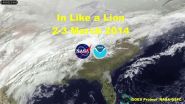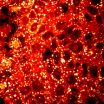(Press-News.org) VIDEO:
This animation of NOAA's GOES satellite data shows the progression of the major winter storm over the US Mid-Atlantic and southern states on Mar. 2 and 3.
Click here for more information.
As NOAA's GOES-East satellite sat in a fixed orbit in space it monitored and provided visible and infrared imagery of the major winter storm that hit the U.S. east coast on March 2 and 3. Now, that data has been compiled and made into a video at NASA.
On March 2 and 3, a major winter storm brought snow to the mid-Atlantic, freezing rain to the Carolinas and rain and some freezing rain to the Gulf Coast states. Visible and infrared imagery over those two days captured by NOAA's GOES-East or GOES-13 satellite were compiled into a video made by NASA/NOAA's GOES Project at NASA's Goddard Space Flight Center in Greenbelt, Md.
"This storm confirms the ancient adage that 'March comes in like a lion,'" said Dennis Chesters of the NASA/NOAA GOES Project at Goddard. Hopefully it will follow the saying and the month will "go out like a lamb."
To create the video and imagery, NASA/NOAA's GOES Project takes the cloud data from NOAA's GOES-East satellite and overlays it on a true-color image of land and ocean created by data from the Moderate Resolution Imaging Spectroradiometer, or MODIS, instrument that flies aboard NASA's Aqua and Terra satellites. Together, those data created the entire picture of the storm and show its movement. After the storm system passes, the snow on the ground becomes visible.
GOES satellites provide the kind of continuous monitoring necessary for intensive data analysis. Geostationary describes an orbit in which a satellite is always in the same position with respect to the rotating Earth. This allows GOES to hover continuously over one position on Earth's surface, appearing stationary. As a result, GOES provide a constant vigil for the atmospheric "triggers" for severe weather conditions such as tornadoes, flash floods, hail storms and hurricanes.
INFORMATION:
For updated information about the storm system, visit NOAA's NWS website: http://www.weather.gov
For more information about GOES satellites, visit: http://www.goes.noaa.gov/ or goes.gsfc.nasa.gov/
Satellite video captures the eastern US winter storm track
2014-03-04
ELSE PRESS RELEASES FROM THIS DATE:
Investigational drug may increase survival for some patients with advanced melanoma
2014-03-04
An experimental drug aimed at restoring the immune system's ability to spot and attack cancer halted cancer progression or shrank tumors in patients with advanced melanoma, according to a multisite, early-phase clinical trial at Johns Hopkins Kimmel Cancer Center and 11 other institutions. All patients had experienced disease progression despite prior systemic therapies, and most had received two or more prior treatments.
Patients who showed responses to the drug, nivolumab (anti-PD-1; BMS-936558; MDX-1106; ONO-4538), survived for an average 16.8 months following initiation ...
Imprint of chemotherapy linked to inflammation in breast cancer survivors
2014-03-04
Many breast cancer survivors experience fatigue and other debilitating symptoms that persist months to years after their course of treatment has ended.
Now researchers at the Winship Cancer Institute of Emory University have found clues that may explain how these symptoms can linger. Chemotherapy, one of the major treatments for breast cancer, can leave a long-lasting epigenetic imprint in the DNA of breast cancer patients' blood cells. That imprint is associated with biological signs of inflammation up to six months after the completion of treatment. Inflammation in ...
Common cancers evade detection by silencing parts of immune system cells
2014-03-04
Johns Hopkins researchers say they have identified a set of genes that appear to predict which tumors can evade detection by the body's immune system, a step that may enable them to eventually target only the patients most likely to respond best to a new class of treatment.
Immune therapy for ovarian, breast and colorectal cancer — treatments that encourage the immune system to attack cancer cells as the foreign invaders they are — has so far had limited success, primarily because the immune system often can't destroy the cancer cells. In a report published online Feb. ...
'Dimer molecules' aid study of exoplanet pressure, hunt for life
2014-03-04
Astronomers at the University of Washington have developed a new method of gauging the atmospheric pressure of exoplanets, or worlds beyond the solar system, by looking for a certain type of molecule.
And if there is life out in space, scientists may one day use this same technique to detect its biosignature — the telltale chemical signs of its presence — in the atmosphere of an alien world.
Understanding atmospheric pressure is key to knowing if conditions at the surface of a terrestrial, or rocky, exoplanet might allow liquid water, thus giving life a chance.
The ...
Cholesterol study suggests new diagnostic, treatment approach for prostate cancer
2014-03-04
WEST LAFAYETTE, Ind. - Researchers have discovered a link between prostate cancer aggressiveness and the accumulation of a compound produced when cholesterol is metabolized in cells, findings that could bring new diagnostic and treatment methods.
Findings also suggest that a class of drugs previously developed to treat atherosclerosis might be repurposed for treatment of advanced prostate cancer.
The research showed depletion of the compound cholesteryl ester significantly reduced prostate cancer cell proliferation, impaired its ability to invade a laboratory tissue ...
Young children form first impressions from faces
2014-03-04
Just like adults, children as young as 3 tend to judge an individual's character traits, such as trustworthiness and competence, simply by looking at the person's face, new research shows. And they show remarkable consensus in the judgments they make, the findings suggest.
The research, led by psychological scientist Emily Cogsdill of Harvard University, shows that the predisposition to judge others based on physical features starts early in childhood and does not require years of social experience. The study is published in Psychological Science, a journal of the Association ...
Research connects drug war violence in Mexico with desensitization in social media
2014-03-04
Amid times of crisis, citizens often turn to social media as a method to share information, make observations and vent. But as a Georgia Tech professor's research into social media use amid the Mexican drug war shows, posts can reveal growing numbness, or desensitization, during times of protracted violence and stress.
Munmun De Choudhury, formerly of Microsoft Research and now an assistant professor in the School of Interactive Computing at Georgia Tech, led the research. Her team's paper, "'Narco' Emotions: Affect and Desensitization in Social Media during the Mexican ...
Spiral galaxy spills blood and guts
2014-03-04
This new Hubble image shows spiral galaxy ESO 137-001, framed against a bright background as it moves through the heart of galaxy cluster Abell 3627. This cluster is violently ripping the spiral's entrails out into space, leaving bright blue streaks as telltale clues to this cosmic crime.
This new Hubble image shows ESO 137-001, a galaxy located in the southern constellation of Triangulum Australe (The Southern Triangle) -- a delicate and beautiful spiral galaxy, but with a secret.
This image not only captures the galaxy and its backdrop in stunning detail, but also ...
Bright pulses of light could make space veggies more nutritious, says CU-Boulder study
2014-03-04
Exposing leafy vegetables grown during spaceflight to a few bright pulses of light daily could increase the amount of eye-protecting nutrients produced by the plants, according to a new study by researchers at the University of Colorado Boulder.
One of the concerns for astronauts during future extended spaceflights will be the onslaught of eye-damaging radiation they'll be exposed to. But astronauts should be able to mitigate radiation-induced harm to their eyes by eating plants that contain carotenoids, especially zeaxanthin, which is known to promote eye health.
Zeaxanthin ...
New evidence confirms link between IQ and brain cortex
2014-03-04
Rate of change in the thickness of the brain's cortex is an important factor associated with a person's change in IQ, according to a collaborative study by scientists in five countries including researchers at the Montreal Neurological Institute and Hospital – The Neuro, at McGill University and the McGill University Health Centre. The study has potentially wide-ranging implications for the pedagogical world and for judicial cases in which the defendant's IQ score could play a role in determining the severity of the sentence.
The cortex is the thin, outermost layer of ...


